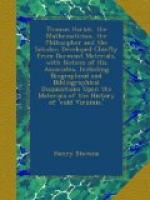Sr, Though I have bene yet soe little a while att New Mar-kett, that I have not any thing of moment to ympart; yet I thinke it not amisse to write a bare salutacons, and let yo know, that in theise wearie journeys I am often times comforted wth the remembraunce of yor kind love and paynes bestowed on yor loytering scholar, whose little credit in the way of learning is all-waits underpropped wt the name of soe worthie a Maister.
The Comet being spent, the talke of it still runnes current here; The Kings ma before mycumming spake w’ one of Cambridge called Olarentia, (a name able to beget beleefe of some extraordinarie qualities) but what satisfaction he gave, I cannot yet learne; here are papers out of Spayne about it, yea and fro Roome, wc I will endevor to gett, and meane yt yo shall partake of the newes as tyme serves.
Cura ut valeas et me
ames, who am ever trulie and unfaynedlyr
yors att Commaund.
THO: AYLESBURIE.
Newmarkett. 19, Jan. 1618/1619
Addressed: To my right woorthie frend Mr. THOMAS HARRIOT
att Syon, theise, fro Newmarkett.
Between 1615 and 1620 there are evidences of Hariot’s failing health. He was greatly troubled with a cancerous ulcer on the lip. How early this began is not apparent. In 1610 his friend Lower cautions him to be careful of his health. There is in the British Museum among the Hariot papers the drafts of three beautiful letters in Latin written from Sion in 1615 and 1616 to a friend of distinction, name not mentioned, who had been recently appointed to some medical office at court, in which he describes himself and his disease.
These letters show great resignation and Christian fortitude. He seemed to be getting better in 1616, and expressed himself as somewhat hopeful. The progress of the cancer and other troubles cannot now probably be traced, but he is found in the summer of 1621 lodging with his old friend Thomas Buckner, in Threadneedle Street, near the Royal Exchange, in the parish of St Christopher. Buckner had been one of Raleigh’s ’ First Colonie ’ to Virginia in 1585 with Hariot, and Hariot, now in 1621, had come up from Sion probably for medical advice near the hospital. On the 2gth of June he made or executed his Will, and died three days after at Buckner’s, on the and of July 1621. He was buried the next day, according to the wish expressed in his will, in the old parish church of St Christopher in Threadneedle Street.
Sifte viator,
leviter preme,
Iacet hic juxta, Quod mortale fuit,
C. V.
THOMÆ HARRIOTT.
Hic fuit Doftiffimus ille Harriotus
de Syon ad Flumen Thamefin,
Patria & educatione
Oxonienfis,
QVM omnes fcientias Caluit,
Qui in omnibus excelluit,
Mathematicis, Philofophicis, Theologicis.
Veritatis indagator ftudiofiffimus,
Dei Trini-uniui cultor piiffimus,
Sexagenarius, aut eo circiter,
Mortalitati valedixit, Non vitæ,
Anno Christi M.DC.XXI. Iulii
2.




